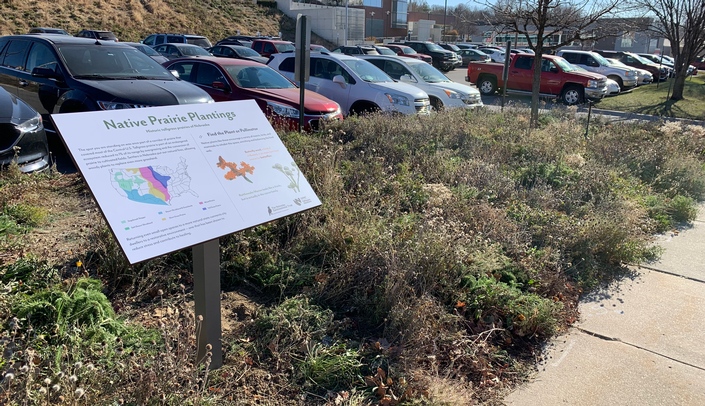Take note of med center’s urban prairies

Thanks to a 2020 grant from the Nebraska Environmental Trust, the med center has replaced turf grass with native prairie plantings in two areas on campus.
The “urban prairies” are designed to increase resources in the urban environment for pollinating insects and birds throughout the growing season. They improve soil health, help mitigate climate change by storing carbon, reduce stormwater runoff and provide a healing environment for med center students, staff, faculty and visitors.
All of those benefits align with the med center’s goals for reducing water use, cutting emissions and increasing engagement. Signage was recently installed at four key areas highlighting facts about Nebraska prairies and the types of plants in the urban spaces.
The med center location was once part of a prairie corridor that covered most of the central United States. But overgrazing and conversion to cultivated fields cut away the prairie. Settlers put out natural fires, allowing woody plants to replace even more grassland.
Today, tallgrass prairie is part of an endangered ecosystem reduced to 1% of its range. Returning even small open spaces to a more natural state connects city dwellers to a restorative environment that can reduce stress.
Prairie grasses have more extensive root systems than turf grass and can store more carbon in the soil. Carbon dioxide and other air pollutants also are reduced by less frequent mowing. Deep-rooted prairie plants hold onto the soil and minimize erosion. Even small plots of prairie can do a lot to manage storm runoff and filter out contaminants otherwise headed into the watershed.
The sites are highly visible in the campus core and adjacent to the Field Club Trail. The first prairie is located on the hillside and adjoining space around parking lot 16 Lower, between the Truhlsen Eye Institute and Home Instead Center for Successful Aging. The second location is along both sides of parking lot 64.
If you have the chance, take a walk to one of the two locations and check out the new signage before winter sets in. Then in the spring, you’ll be able to spot the different plants and pollinators noted on the signs.
